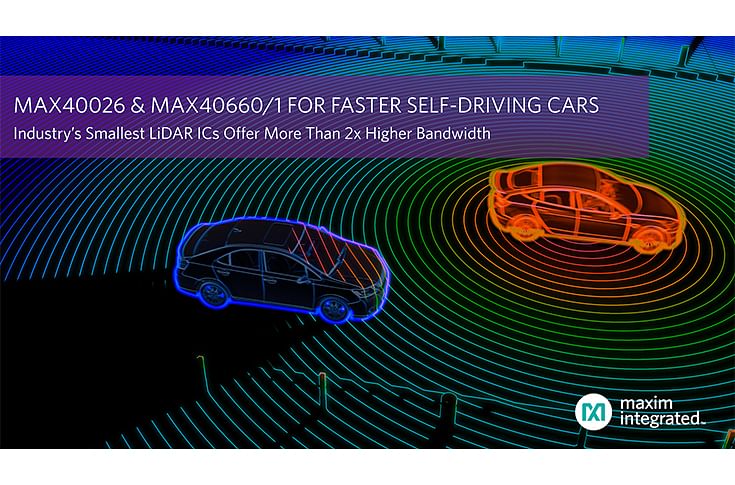Maxim develops new LiDAR IC for higher resolution images and faster processing
Maxim claims that the new ICs which are the fastest and the smallest LiDAR ICs could enable higher-speed autonomous driving
Maxim Integrated, the US-based integrated circuit specialist claims to have developed the world’s smallest LiDAR ( Light Detection and Ranging) ICs with twice the higher bandwidth, thus enabling faster self-driving cars.
The MAX40026 high-speed comparator and the MAX40660/MAX40661 high-bandwidth transimpedance amplifiers claim to enable 10mph (15km/h) faster autonomous driving at highway speeds by providing more than 2x higher bandwidth and accommodating 32 additional channels (128 vs. 96) to a LiDAR module within the same module size. It is reported that the MAX40026 TDFN package size of 4mm2 and the MAX40660/1 TDFN package size of 9mm2 provide the industry’s smallest overall solution size. Maxim’s TIAs support 128 channels with the industry’s highest bandwidth of 490MHz for MAX40660 and 2.1pA/√Hz input-referred noise density to support higher accuracy distance measurement in LiDAR applications; in addition, low propagation delay dispersion of the MAX40026 (10 picoseconds) contributes to accurate detection of both fixed and moving objects. Maxim also claims that MAX40660/1 reduces current consumption more than 80 percent in low power mode.

With more than twice the bandwidth and the ability to accommodate 33 percent more channels within the same LiDAR module size compared to the closest competitor, the MAX40660/MAX40661 transimpedance amplifiers (TIAs) provide optical receiver designers with higher-resolution images that enable faster autonomous driving systems. Maxim claims that the system size of the MAX40026 high-speed comparator plus the MAX40660/1 TIAs is 5mm2 smaller than the closest competitive solution, which allows developers to fit far more channels into space-constrained vehicle platforms. These ICs meet the stringent safety requirements of the automotive industry with AEC-Q100 qualification, enhanced electrostatic discharge (ESD) performance and failure modes, effects and diagnostic analysis (FMEDA) to support ISO 26262 certification at the system level.
Veronique Rozan, executive director of business management, Core Automotive and Special Projects at Maxim Integrated said, “Automotive engineers need elements that support greater precision, lower power and smaller solution size in order to add next-generation LiDAR capabilities to cars rolling off the assembly line. Advancements in LiDAR-based solutions will support greater driver awareness and safety from next-generation automotive navigation systems.”
Conny Heiler, director of Marketing at First Sensor said, “Excellent sensors need an excellent signal chain. It has been a pleasure collaborating with Maxim to create a joint evaluation kit leveraging each of our high-bandwidth LiDAR solutions.”
RELATED ARTICLES
Skoda begins sale of made-in-India CKD Kushaq in Vietnam
Before production started, pre-series Kushaq vehicles covered over 330,000 kilometres on a variety of Vietnamese roads a...
Six Japanese companies join forces to expand use of recycled materials in new vehicles
Denso, Toray Industries, Nomura Research Institute, Honda Motor, Matec Inc and Rever Corporation have set up the BlueReb...
BYD selects Voestalpine as steel supplier for its Hungarian plant
The announcement of the Austrian steelmaker as a supplier demonstrates BYD’s strategic plan to source from high-quality,...





 By Autocar Professional Bureau
By Autocar Professional Bureau
 26 Feb 2020
26 Feb 2020
 7666 Views
7666 Views









